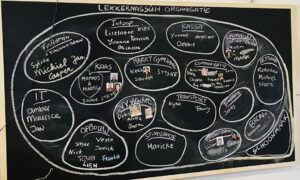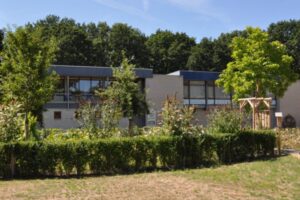Besides the weekly vegetable packages, from 18 April 2025 it will also be possible to order a Lekkernassuh Bio-Fruit package. With this, we are taking a new step in the sustainable food transition.
How does it work?
- Order your Bio-Fruit package every week before Sunday 8pm.
- As with our Bio-Fruit package, the weekly ‘Lekkernassûh e-mail’ will indicate how much of each fruit variety is in that week’s package.
- The package changes every week and consists of 4 to 5 types of organic fruit. Apples (alternating varieties) and bananas are often a regular part of the pack.
- You get around 2.5 kg of organic fruit in your package. This may be less, if we supply grapes, berries and other summer fruits or more exclusive fruits. The 2.5 kg mentioned now gives an impression of what you can expect. Before ordering, you will have received an email with the types of fruit for that week, totalling about 2.5 kg. Furthermore, we strive not to include too large pieces of fruit in the Bio-Fruit package: we would rather several smaller apples than, say, 2 very large ones.
- The price of the Bio-Fruit package is 10 euros (incl. VAT).
- The Bio Fruit bag will be collected during the Lekkernassuh market on Wednesday.
- The LN Bio-Fruit package is delivered in a paper bag at the Lekkernassuh market. The paper bag prevents the fruit from being damaged during transport. Each participant can put the organic fruit in their own bag. The paper bag is left at the market and folded: the packaging is reused by the supplier. The paper bag is expected to last at least 5-10 times. We are also looking at even more sustainable solutions, such as a jute bag or a special collapsible crate without paper. Check below how to fold your bag, so it can be reused.
- For each type of fruit, the grower is mentioned. Regularly, there is more explanation about the cultivation and details about the growing season (rain, sun, drought, etc.).
The advantages of an LN Bio-Fruit package (compared to a supermarket) are:
- Surely we aim for efficient transport if possible (by ship on the long distances can be more sustainable out than truck on a much shorter route) and not too long storage conditions (i.e. out of the season)
- Good quality: organic fruit from growers with whom our supplier has a longer relationship.
- Seasonal fruit: we supply as much seasonal fruit as possible (storage period as short as possible)
- Varied supply: we provide a weekly variety of fruit; be surprised.
- Attractive price: experience has shown that the kg price of organic fruit is lower or equal to the supermarket.
- Local growers (if possible): initially we supply what is available in the Netherlands, then in Europe and possibly outside Europe if not otherwise possible.
- Fresh fruit: we aim to supply fruit that is not kept in a cold store for a long time. For example, we deliver an apple variety in the harvest season specific to that variety.
- Transparent origin*: of each fruit variety, we try to indicate the grower with an explanation of the variety. See explanation below for when no grower is mentioned.
- Minimal packaging material: paper bags are reused.
- Know what you eat: we often provide information and explanations about the type of fruit and how the season, climate or soil has affected the taste. This gives you an insight into where and how the fruit grows.
- Low footprint**: through local sourcing of seasonal organic fruit, minimal packaging and selection of organic fruit with the lowest possible footprint .
* We source the fruit from Kievit in Katwijk. Internationally, Kievit sources organic fruit where they cannot buy it directly from the growers through specialised importers (such as Solid Organic Link). These importers are selected for reliability, i.e. they only source from organic-certified fruit growers who can demonstrate a reliable and long-term track record. Since this often involves quantities from different growers internationally within a delivery, it is not possible to identify within the country or region who the specific grower of the fruit is.
**Footprint of fruit explanation: the biggest footprint reduction of fruit can mostly be achieved through organic cultivation. Unfortunately, it is very difficult to compare footprint per type of fruit (given the huge number of variables such as distance, growing and harvesting working conditions, agricultural acreage requirements, water requirements of the crop, storage conditions and how long it is stored, etc.).



Interested? Check out the contents of the fruit pack at This Weeks Fresh Package and order it via your personal profile. This is where you specify how many fruit and vegetable packs you want to order from now on.
Please note that we only buy if you are on ACTIVE!
Not a member yet? Then register here.
Below is an instruction video on how to fold the bag. Only properly folded bags can be taken back for reuse. Will you help?
We look forward to seeing you at the market!
Photo by Franka



